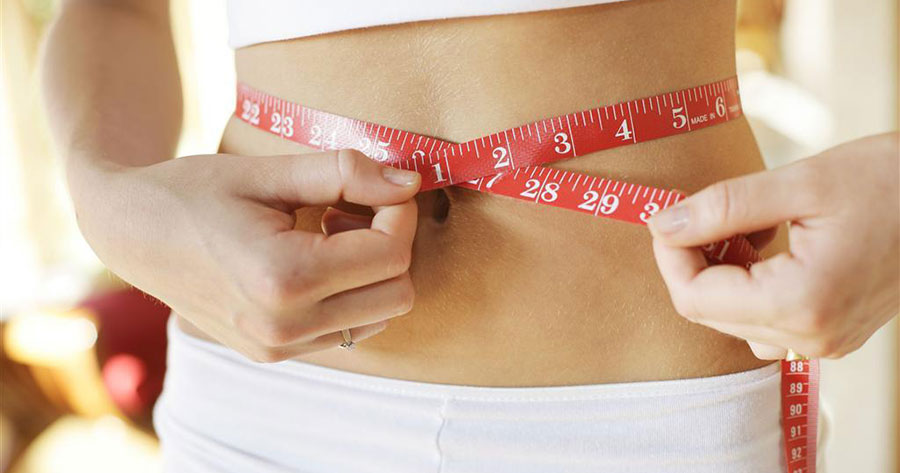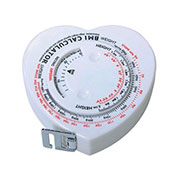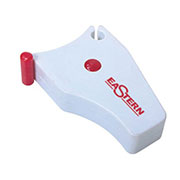How to Measure Your Waist with Tape Measure
For your best health, your waist should be less than 40 inches around for men, and less than 35 inches for women. If it's larger than that, you may want to talk with your doctor about what your next steps are, including losing weight.
You can’t spot-reduce your waist, or any other part of your body. Crunches will strengthen your abs, but to lose inches around your waist, it will probably mean eating fewer calories and burning more off through exercise.
Your waist circumference that is easy to measure is an important number, it is a clue to whether you're at higher risk for type 2 diabetes, high blood pressure and heart disease. All of these can be done by a flexible tape measure, especially, a waist tape measure or a BMI tape.

Measuring Your Waist Circumference
To measure waist size correctly, you should use a flexible fiberglass tape measure that is not elastic. The tape measure should not stretch when you are taking your waist measurement. A professional waist tape measure or a BMI measuring tape is a good choice.
First of all, remove or lift clothing
To get an accurate measurement, you have to make sure that the fiberglass tape measure is resting against your bare belly, so you should remove any bulky clothing that can add padding around the abdomen. Remove your shirt or lift it to just below your chest.
Find your waist
Stand up and use your fingers to find the top of your hip bone and the base of your rib cage. Your waist is the soft, fleshy section between these two bony parts, It will also be the narrowest part of your torso and it is often located at or above your belly button.
 |
 |
 |
|
BMI-52 1.5M Metric/Inch Heart Shaped BMI Fiberglass Measuring Tape |
WT-D17 1.5M Imperial and Metric Waist Tape Measure (Body Fat Tape) |
TT-SR01 Fiberglass Tailor Tape |
Wrap the fiberglass tape measure around the waist
Bring the fiberglass tape measure around the widest part of your waist, across your belly button above a bit. Stand up straight and breathe normally. Hold the end of the fiberglass tape measure at your belly button and circle it around your back to the front of your waist. The tape measure should rest gently on your skin. and fit snugly around your torso without digging into your skin. Once the tape measure is positioned correctly, breathe in gently and then take the measurement on the exhale.
If you ae using a professional waist tape measure or a BMI tape, then you can
- Lock the rod (also called pin) at the end of the tape forming a circular tape wrapping the body part.
- Press the button in the center,and let the tape retract to fit snuggly on your body.
Note:
- Make sure that the measuring tape is straight all the way around and is not twisted anywhere, especially in the back. Holding the tape too tight so that it digs into your flesh, or holding it too loosely so that it droops will cause you to get an incorrect result.
- Don't hold your breath while measuring.
Read the tape measurement
Check the number on the tape measure right after you exhale
Your waist measurement will be at the place on the tape where the zero end meets the slack end of the tape measure. The number indicates your waist measurement in inches and/or centimeters, depending on the type of measuring tape you used.
Double-check your measurement
Take the measurement two or three times to make sure the accuracy of your original measurement. If it is different from the first time, measure for a third time and take the average of the three numbers.
Interpreting the Results for Your Reference
What is the ideal measurements for a woman?
The specific proportions of 36–24–36 inches (90-60-90 centimeters) have frequently been given as the "ideal", or "hourglass" proportions for women since at least the 1960s.
Ideally, all should aim to keep their waist measurement less than half that of their height, found the scientists. That means a 6ft (72 inch) tall man should aim to keep his waist less than 36 inches, while a 5ft 4in (64 inch) woman should keep hers under 32 inches.
What is a dangerous waist size?
If most of your fat is around your waist rather than at your hips, you're at a higher risk for heart disease and type 2 diabetes. This risk goes up with a waist size that is greater than 35 inches for women or greater than 40 inches for men.
How do I reduce my waistline?
Here are 6 evidence-based ways to lose belly fat.
- Don't eat sugar and avoid sugar-sweetened drinks. ...
- Eating more protein is a great long-term strategy to reduce belly fat. ...
- Cut carbs from your diet. ...
- Eat foods rich in fiber, especially viscous fiber. ...
- Exercise is very effective at reducing belly fat.
What's the most attractive body shape for females?
Men and women barely differed in their opinion of what an ideal body looked like, whether the ideal was for a male or a female. Essentially, the male ideal is an inverted pyramid with broad shoulders and small waist, while the female ideal is an hourglass with a small waist-to-hip ratio.
What is the most attractive BMI?
This was then collated and the most attractive BMI was found to be 20.85. To put that in a frame of reference, a woman who is 5 foot 6 or 168 centimeters tall would have to weigh 58.5 kilos or 129 pounds. The study also found that 75% of a woman's physical attractiveness to men is determined by her BMI.


